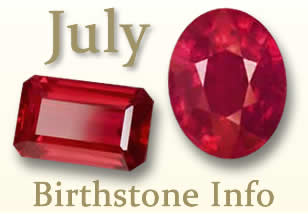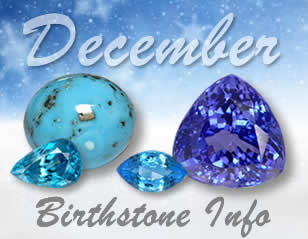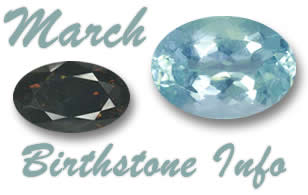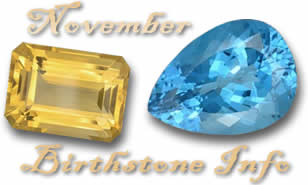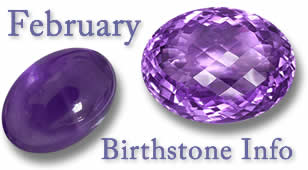What can I find in this article?
- What are the colors of the September birthstone?
- History of the Sapphire
- What is the significance of the September birthstone?
- The healing properties of sapphires
- Taking Care of Your September Sapphire Birthstone
- How much do sapphires cost?
- Are There Any Secondary September Birthstones?
- Final Thoughts
Sapphire - the September Birthstone
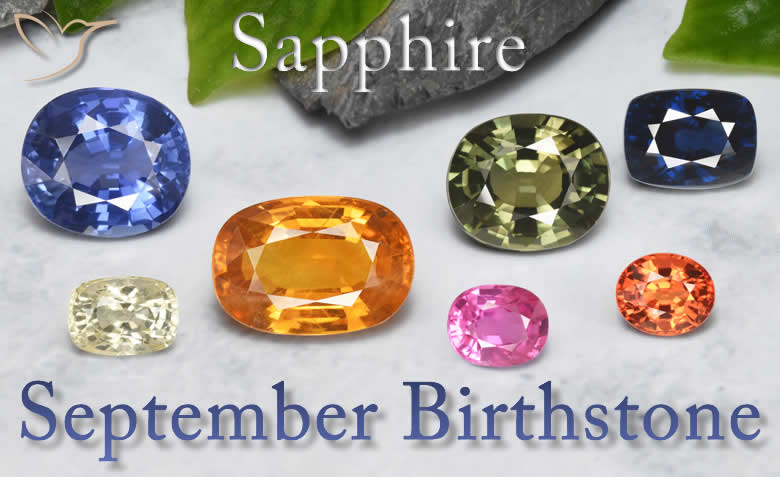
There are twelve birthstones for each month of the year; your birth month determines which applies to you. But a birthstone is more than that...it is a way for us to celebrate our birth into this world and our connection with the elements that gave us life. Each of the twelve primary birthstones have distinct characteristics and qualities – just like we do – and wearing them reminds us of who we are and where we came from, as well as inspires us to be who we dream of being and to go to the places we dare to go.
For people who love gemstones, no gift is more thoughtful or more appreciated than a piece of birthstone jewelry. Let us guide you on an exploration of the history and lore of the September birthstone, as well as some of the secondary stones, where you will abound in the mystical, the fantastic and the beautiful!
The September birthstone - Sapphire
Long before people understood chemical composition and could, therefore, classify gemstones into groups, species or variety, color was the primary trait used to group minerals. As a result there were very broad groups into which many gemstones with very different characteristics were lumped together. Sapphire is one of these gemstones.
The name sapphire comes via Middle French and Latin, and is mainly attributed to an Ancient Greek word, sáppheiros, meaning ‘precious stone’, though it may ultimately be traced back to a Sanskrit word, śanipriya, meaning ‘dark-colored stone’.
It is this last point of reference that gives us a look at the very general methods of classifying gemstones in ancient times: the word sapphire was used to describe any dark-colored stone of value, usually lapis lazuli, azurite or the deep-blue corundum that typifies what we popularly think of when we see or hear the word sapphire.
However, as we know today, thanks to gemology, sapphires are not contained only to this color; in fact, they come in all colors across the visible spectrum – even grey!
The only color that does not apply to sapphires is ruby-red because those are…rubies (sapphire and ruby are in the same family – corundum).
So, while the word sapphire was used in ancient times to refer to a large body of dark-colored (usually blue) stones, it is today used to refer to a large body of colored corundum that ranges from orange hues to yellows, greens, purples and, of course, blues.
According to the Jewelers of America, who established the authoritative list of birthstones in 1912, sapphire is the official September birthstone.
And, while they do recognize that the deep-blue variety of sapphire is the most popular, they encourage you to choose from the wide range of colors when selecting a September birthstone for you or your loved one.
As previously mentioned, sapphire is the name of any color of corundum (aluminium oxide) except red; at least the blood-red that is strictly reserved for ruby. Though colorless sapphires are rare, they were once used as diamond imitations; today they are commonly used as accent stones (small, simple-cut stones set around a center stone to increase its brilliance).
Sapphires are split into two main color categories: the traditional (blue and colorless), and fancy (pink and purple, orange and yellow, green, black, etc.).
The most sought after fancy sapphire is the very rare padparadscha sapphire, a pinkish-orange sapphire named from the Sinhalese (a Sri Lankan language) for ‘aquatic lotus flower’.
Unfortunately, there is no universal definition for the hues, tones and color saturation that define the padparadscha sapphire; therefore, the color that can be called padparadscha is open to interpretation, which can lead to conflict in the gemstone market, especially considering the very high price buyers are willing to pay for a true padparadscha sapphire.
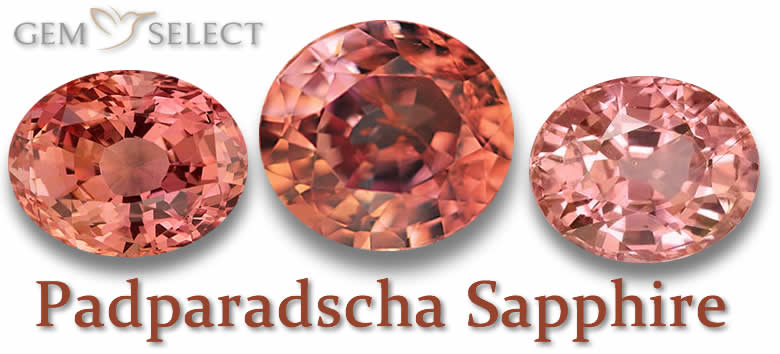
Fancy sapphires contain a sub-group of colors called parti-colored sapphires (or parti sapphires) that show combinations of different colors. Parti sapphires are created from sapphire crystals that have two or more distinctly different colors zones and are cut in a way that allows these zones to be part of a single gemstone. A common example would be an emerald cut parti sapphire that displays three zones: blue and yellow, with a greenish transition in between. Or a Pharaoh's Eye parti sapphire which is created by a yellow crystal core surrounded with blue, producing a kaleidoscope of blues, yellows and greens.
Some sapphires are known to exhibit a phenomenon called ‘color-change’; though this effect is rare, the most common type of it is when a sapphire goes from blue in daylight or fluorescent lighting to purple under incandescent light. Even more rare is the color-change sapphire which changes from green in daylight to reddish brown in incandescent light.
Color change is not to be confused with pleochroism, which is also exhibited by sapphires. Pleochroism is when a gemstone has different colors when viewed from different angles. Corundum is a pleochroic mineral and can show various different colors; for example, purple can show orange, blue can show light blue-green, and pink can show orange-red, among others.
Another phenomenon found in sapphires is the asterism, or star effect, usually appearing as a three-crossbeam, six-ray star pattern visible across a cabochon-cut stone’s curved surface.
The asterism is a result of light reflecting off tiny needle-like inclusions and can occur in any color of corundum. The most valuable ‘star corundum’ are those with a color background that is strong enough to contrast the star pattern, and among these red and blue are the most sought after. Only the red asterism may be called ‘star ruby’, while any other colors may be called ‘star sapphire’.

The Ancient Persians knew the sapphire as ‘The Celestial Stone’ and believed that the world rested on a giant sapphire pedestal that painted the sky blue with its reflection. The theme of sapphire as a connection with the divine and heaven continues through Ancient Greek and Roman mythology and into Christendom.
The Greeks associated sapphire with Apollo, the prophetic deity of the Oracle at Delphi. Worshippers seeking help and advice from the Oracle would wear sapphire to garner Apollo’s favor and open their ‘third eye’, making it easier to understand the prophesy. Moreover, it was a commonly held belief among ancient Greeks and Romans that wearing blue sapphires would protect one from envy, infidelity and harm.
The Hebrew bible explicitly mentions sapphire 12 times and relates this gemstone to the Lord’s character and divine nature.
There are numerous occasions where sapphires are placed under the Lord’s feet, indicating that all the Lord does is based on the foundation of His divinity, reflecting the ancient beliefs that the word was supported by a sapphire pedestal.
There are many who believe that the blue stone tablets used to carve The Ten Commandments were sapphire and this notion is supported by what we know of the relative hardness of sapphire. On the Mohs hardness scale, sapphire is 9, making it an ideal surface to engrave with a hammer and chisel.
By the 12th century, sapphires had become closely associated with clergy, and ecclesiastical rings set with sapphire began to be worn by bishops and others to symbolize their direct connection with Heaven. A particularly special type of ecclesiastical ring would feature a star sapphire, for it was thought that the three crossbeams of the star represented the holy trinity: the Father, the Son and the Holy Spirit. Other Christians were inclined to call the star sapphire ‘The Stone of Destiny’ and attribute the three crossbeams to faith, hope, and destiny.
The Christian symbolism continued to permeate the cultural relevance of sapphire to such a degree that it was widely believed during the middle ages that a vessel made of sapphire would kill a venomous serpent if placed in it.
There are numerous myths and legends that surround sapphire that go back further in history than the Persians, Greeks and Christians. In the Hindu Vedic literature, widely considered the world’s oldest religious scripture, the Kalpavriksha (or Tree of Life) reportedly had the fruit of rubies, the trunk of diamonds, and the roots of sapphire. This imagery seems to be a possible origin for the Persian, Greek and biblical iterations of the concept of sapphire symbolizing an all-permeating supportive force in the universe.
Another ancient myth comes from the Khmer civilization, a people who inhabited what is today Myanmar. They tell of the Birman legend, a story in which a temple cat is transformed into a divine incarnation of the Golden Goddess called Tsun-Kyan-kse, whose prominent characteristics were blue sapphire eyes.
A fascinating Persian tale of the sons of the king of Serendip (the Old Persian name for Sri Lanka) recounts how the boys, who set out to discover the reality of the world, happened upon a sapphire mine. This legend accounts for the origin of the notion of serendipity - the occurrence and development of events by chance in a happy or beneficial way.
Today, Sri Lanka remains one of the most important sources of sapphires. Most of the world’s sapphires come from the Australian territories of Queensland and New South Whales, Sri Lanka, Madagascar, Thailand, North America, Tanzania and other African countries.

Sapphire is a symbol of nobility, truth, sincerity, and faithfulness, which is why it has been favored by royalty seeking to embody these virtues. It is also believed to bestow gifts of fulfillment, joy, prosperity, inner peace, and beauty.
Throughout history, sapphires have been associated with the power to foster harmony in relationships and resolve conflicts. They are said to bring a sense of calm in social settings and have the ability to reveal deception. Wearing sapphire jewelry is thought to be beneficial for individuals involved in legal matters.
In astrology, the blue sapphire is connected to the planet Saturn and Saturday, while the white (or colorless) sapphire is associated with Venus and represents Friday, the day dedicated to that planet.
Sapphire’s symbolism extends to springtime, as well, and in differing zodiacal systems, this gemstone covers both Taurus and Gemini.
Today, sapphire is still a stone of wisdom, learning, mental acuity and psychic activation. Its pure blue color is associated with order and healing of the mind, lending strength and focus, and an ability to see truths and to utilize that knowledge. The blue of sapphire represents the throat and third-eye chakras, which are the seats of communication and awareness, respectively.
It is thought that meditating with sapphire in your hand can help you get wonderful inspiration and ideas that’ll support your creativity and expressions of power. Perhaps this is why many creators and artists prefer sapphire’s properties and effects.
The notion of a sapphire engagement ring, which symbolizes sincerity and faithfulness, was made popular in 1981 when Prince Charles gave Princess Diana a blue sapphire engagement ring that she wore while she captivated the world. Today, that ring is proudly worn by Prince William’s bride Kate Middleton. Many celebrities, including Penelope Cruz and Elizabeth Hurley, have followed this fashion of wearing a sapphire engagement ring, wedding them to the ancient virtues symbolized by this precious gemstone.
When it comes to sapphire as the September birthstone, this gemstone is thought to have a special power for protecting those born in September.
The sapphire shields those born in this month against negative thoughts and brings a positive structure and order to their life.
Sapphire possesses strong protective properties which resonate on sacred spheres; virtually all religions in the world speak of the September birthstone with respect and awe. It makes an excellent protective talisman, especially when there’s a risk of psychic, mental, or emotional attack.
This precious gem strengthens and awakens the link between the higher and the physical self. Wearing sapphire jewelry frequently helps you develop a stronger bond with your spiritual team, including the healing guides, spirit guides, guardian angels, and even passed loved ones. It can assist you in times of change by providing clearer visions you need to reach your dreams and complete your goals. Sapphire’s power to transmute negative thoughts and energy also makes it highly effective for earth and chakra healing.
Regarding sapphire and physical health, this gem can improve your bone density, as well as overall strength. This excellent gemstone can also support good physical strength for people who’ve undergone reconstructive surgery where titanium is commonly used, promoting post-surgical healing while providing the energy to calm inflammation.
Sapphire can also be useful for those suffering from dementia or Alzheimer’s disease. It helps them by stimulating both the pituitary gland and the thyroid gland. Moreover, it revitalizes the auric field and detoxifies the skin.
The September birthstone is also known for quelling fevers, stanching nosebleeds, reducing inflammation and curing infection. Many have reported positive results in using sapphire to heal burns. Overall, sapphire accelerates all healing processes by influencing the willpower to get well.
At 9 on the Mohs hardness scale, sapphire is the hardest and most durable gemstone after diamond. It has excellent toughness and no cleavage, which is a tendency to break when struck. This makes it a great choice for rings and other mountings subject to daily wear.
However, it still requires a little maintenance to prevent against the regular wear and tear it may experience after frequent, everyday use. As we all know, any jewelry can accumulate grime and dirt over time, making it look dull and unappealing.
Though sapphire is highly stable under normal conditions, meaning that it’s resistant to the effects of heat, light, and common chemicals, boric acid powder will even etch the surface of untreated stones. Moreover, fracture-filled, cavity-filled, and dyed stones can be damaged by even mild acids like lemon juice.
A little care will go a long way in ensuring that your most cherished sapphire jewelry remains dazzling at all times. You don’t need any special jewelry cleaner or polish to remove the dirt and filth from your sapphire. All you need is adequate warm water to cover the piece, a soft toothbrush, and a mild de-greasing dish detergent.
Warm, soapy water is always safe. Ultrasonic and steam cleaners are usually safe for untreated, heat-treated, and lattice diffusion treated stones, while fracture-filled, cavity-filled, or dyed material should only be cleaned with a damp cloth.
Below is a comprehensive guide on how to wear, clean and store your precious birthstone of September:
- Wearing – You’re advised to wear your sapphire jewelry with care. The rule of thumb is to only wear it after you’re through with your makeup. In so doing, your sapphire jewelry will remain safe and free from damage that may be caused by makeup products like hair sprays.
- When to remove the jewelry – Always take off sapphire jewelry while doing such manual tasks as gardening, housework, or lifting. While sapphire is generally considered a hard stone, chances are that some manual activities can cause it to chip, scratch or shatter. If knocked by some of these manual jobs, your jewelry is likely to become loose and fall out of its setting. Why take that risk?
- Exposure – Exposing sapphire jewelry to harsh substances containing abrasives, moisturizers or anti-static agents is not recommended. Harsh chemicals like chlorine bleach can damage or discolor the jewelry or coat the stone with chemicals. For this reason, never bathe or swim with your jewelry – take it off when hand-washing clothes, cooking, or cleaning utensils.
- Cleaning – You can safely clean your sapphire birthstone at home using warm water and a splash of mild degreasing detergent. It’s also safe to gently scrub it with a soft toothbrush. After cleaning, rinse it thoroughly with clean water and dry with a soft cloth – air drying will leave spots. If the need arises, you can deep clean your sapphire jewelry by soaking it in lukewarm water for 10-15 minutes.
- Proper storage – Once you’ve properly cleaned and dried your sapphire jewelry, wrap it in a piece of jewelry cloth, muslin cloth, or place it in an acid-free paper envelope. To prevent it from being scratched or scratching other stones, make sure to place it in a separate compartment inside the jewelry box. Always store jewelry in a cool, dry place away from heat or direct sunlight.
Buying loose sapphires can be a lot of fun because there is so much to choose from; with dozens of color variations and effects, you are only limited by your imagination…and your budget. While price will depend on color, clarity size and weight of the gemstone, the type of treatment that it has had will be the primary factor in the cost.
Synthetic sapphire is something commonly found on the market and, though it is chemically identical to natural sapphire, its value is extremely low and is often used for costume jewelry. Reputable gemstone dealers typically do not sell synthetic sapphires.
Low cost natural sapphire tends to be mostly treated or lower quality material. Lower grade material is typically of inferior color or clarity. Some of the lower grade material of poor transparency is cut as cabochons rather than faceted. If the color is good, these can be very attractive, but they will sell for much lower prices than facet-grade stones. For example, one can purchase a 1.2 carat blue star sapphire cabochon, sized about 7 x 5 mm for $20 only.
The most common treatment method for sapphire is heat treatment, which involves high-temperature heating that affects impurities in the sapphire, such as titanium or iron. The end result is often an improvement in both the color and clarity of the gem. Heat-treated sapphires with top color and clarity can be relatively expensive - though affordable - especially in large sizes. For example, a 3 carat oval orange sapphire, sized 8 x 7 mm could be purchased for $750.
The rarest and most expensive sapphires are completely untreated. Sometimes they may be found at affordable prices in small sizes (under 1 carat), but unheated sapphires over 1 carat will generally be expensive. Large stones (over 2 carats) with very good color can easily sell for $2000 per carat and often more. Consider a 3.4 carat cushion blue sapphire, sized 9 x 6.7 with a price just over $12,000.
In the United States, the birthstone associated with September is the sapphire. In truth, however, there are six other stones that have been linked to this month of seasonal transition. Modern September birthstones came into existence in the early 20th century when gemstone societies from different parts of the world selected new stones for use as birthstones in jewelry.
One of the popular September birthstones is the lapis lazuli, which is an alternative to sapphire in the United Kingdom. It’s been cherished by ancient kings and queens because it’s revered for having the ability to calm and bring peace to a home. Lapis lazuli has a sacred connection to the heavens and starry skies, as well.
Other traditional September birthstones date back to the 15th century, when the birthstone color was of ultimate significance. Ancient Arabic, Russian, Italian, and Hebrew calendars listed peridot as the birthstone of September, albeit it is presently the modern birthstone of August. Peridot is associated with positive energy which opens up the heart of chakra, and thus clears blockages in your life.
Sardonyx was once the September birthstone in the Roman Empire, as well as modern Italy. It’s thought to be a strong protective stone whose positive vibrations can raise the levels of optimism, confidence, and joy. It also helps students to focus on learning and retain what they’ve learned.
Another popular September birthstone that’s been held sacred in different cultures is the moonstone. It was considered a talisman of protection with a potent correlation to moon energy. It was believed to protect nighttime travelers, as well as open the heart to love and passion. Some cultures also considered it a stone that brings blessings of all kinds – heath, wealth, friendship, and more.
In ancient Tibet, the birthstone for September was agate. It was first found in the Achates River in Sicily, for which it is named. This ancient September birthstone can stabilize and strengthen the individuals who wear it.
Lastly, there’s the Hindu September birthstone known as zircon. There are many zircon varieties in existence, but the blue version was considered the September birthstone on the Hindu calendar. The blue zircon helps you find inner peace by uplifting and balancing your mind and emotions.
Sapphire is practically the perfect birthstone. Not only are endless color varieties to choose from, the incredible durability of sapphire makes it ideal for any use in jewelry. People who have a September birthday are truly lucky to have such a meaningful and versatile birthstone!
In all its celestial hues, sapphire emerges as a holy and magnificent birthstone. The blue color is a clear-cut reflection of the colors of the sky and a symbol of the virtues of life. Wearing this precious gemstone will not only calm your emotions, but it will also bring more respect, trust, faith, and patience to your life.

